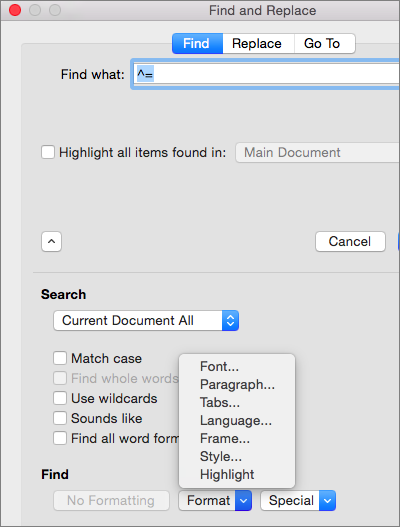
Or to delete all manual page breaks, replace ^m For instance, to replaceĪll manual line breaks with paragraph marks, you would replace ^l Selected Paragraph Mark, ^p will be inserted.ĭo the same in the Replace With box. If you use the Special button, a special code representing the non-printing character Happen to know that the character code you needed was ^p, click the Special button, and select an item from the In the Find What box to represent a paragraph mark) or, if you didn't In the Find & Replace dialog, click in the Find What box andĮither type the character code you need (for instance, you can type ^p Finding & Replacing non-printing characters Controlling which sections of the document are acted upon.Finding & Replacing other special characters.Finding & Replacing non-printing characters.(in)> finds "in" and "within," but not "interesting.Finding and replacing non-printing characters (such as paragraph marks) and text formatting One or more occurrences of a character or finds "lot" and "loot."

Tck finds "tock" and "tuck" but not "tack" or "tick."Įxactly n occurrences of a character or expressionĪt least n occurrences of a character or expressionĪ range of occurrences of a character or expression


Mst finds "mist" and "most" but not "mast."Īny single character except characters in the range inside the brackets Ight finds "right" and "sight" and "tight."Īny single character except the characters inside the brackets You can refine a search by using any of the following wildcard characters. Select Replace All, Replace, or Find Next. Select Special, select a wildcard character, and then type any additional text in the Replace with box. Select the Replace tab, and then select the Replace with box. Word will find "Newman Belinda" and replace it with "Belinda Newman." For example, type (Newman) (Belinda) in the Find what box and \2 \1 in the Replace with box. You can search for an expression and use the \ n wildcard character to replace the search string with the rearranged expression. For example, search for to find "presorted" and "prevented."

You can use parentheses to group the wildcard characters and text and to indicate the order of evaluation. For example, type \? to find a question mark. To search for a character that's defined as a wildcard character, type a backslash (\) before the character. You can also enter a wildcard character directly in the Find what box instead of selecting an item from the Special pop-up menu. To cancel a search in progress, press + PERIOD.


 0 kommentar(er)
0 kommentar(er)
